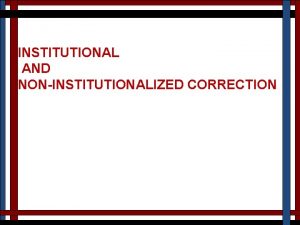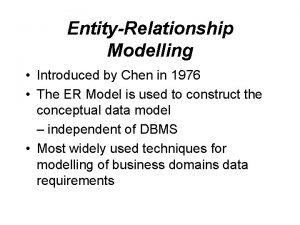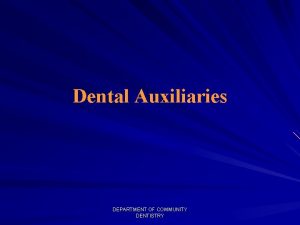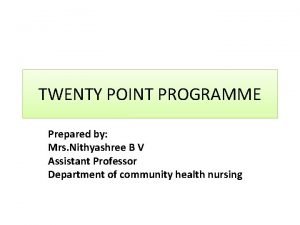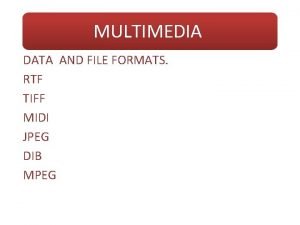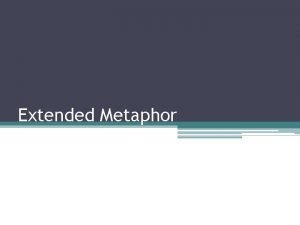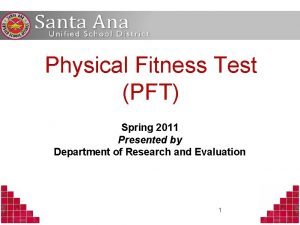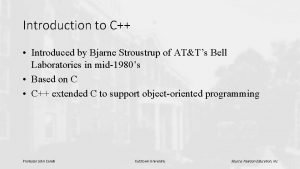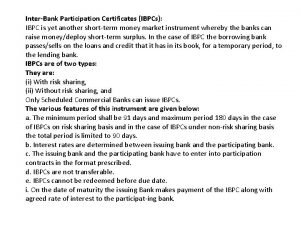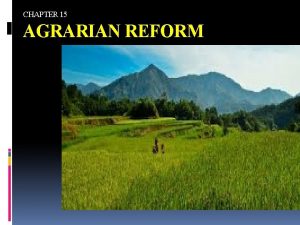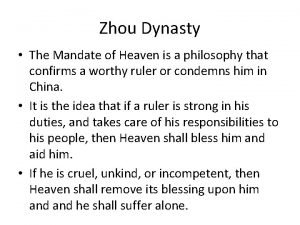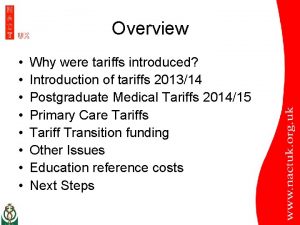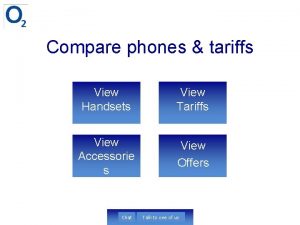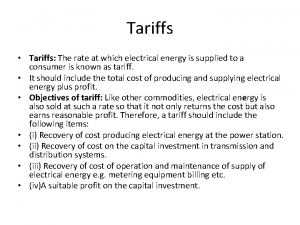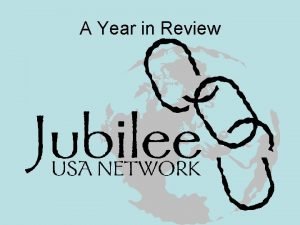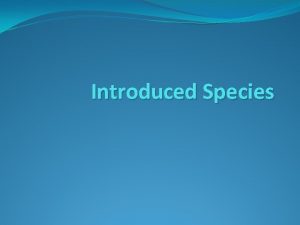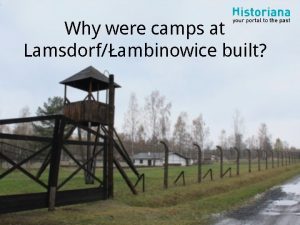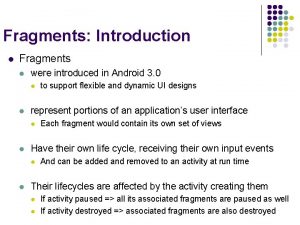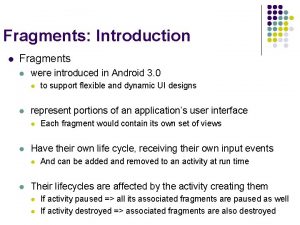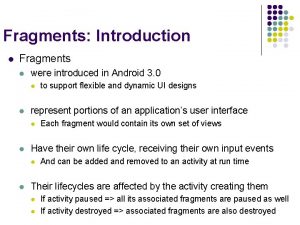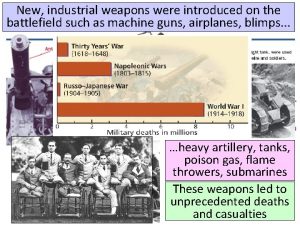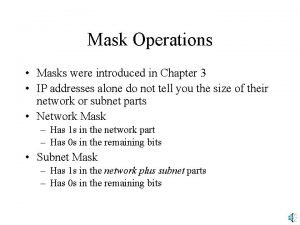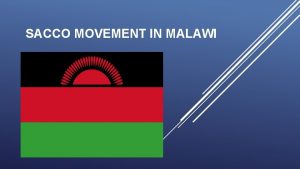Overview Why were tariffs introduced Introduction of tariffs



































- Slides: 35

Overview • • Why were tariffs introduced? Introduction of tariffs 2013/14 Postgraduate Medical Tariffs 2014/15 Primary Care Tariffs Tariff Transition funding Other Issues Education reference costs Next Steps

Why were tariffs introduced • Remove inequities and inconsistency in the historical systems • Support commissioning based on quality rather than price • Identify and remove cross subsidisation • Move to a system in line with Service funding • Aim is for payments should reflect the true costs of training • Simple enough to be workable but detailed enough to pay Trusts fairly

Introduction of Tariffs 2013/14 • Tariffs were introduced for clinical placements in both undergraduate medical and non-medical areas and are now in operation: • – Undergraduate medical tariff : • £ 34, 623 per student WTE + MFF (market forces factor) • Excludes primary care – Non-medical tariff : • £ 3, 175 per student WTE + MFF

Postgraduate Medical Tariffs 2014/15 • Tariffs have been introduced for clinical placements in postgraduate medical: Postgraduate medical tariff for doctors in training: • 50% salary cost per WTE plus placement fee of £ 12, 400 + MFF

PG Medical Tariff Calculations

Scope of PG Medical Tariff (1) • Postgraduate Placement Fee includes: – Study leave – Administrative and employer costs – Library & Infrastructure (including clinical tutor salaries) – – – And excludes TPDs Primary Care GPR posts in practices Dental F 1 posts Public Health posts Academic, NIHR, Leadership & Management posts

Scope of PG Medical Tariff (2) – F 2 GP posts to be excluded – Hospice Placements to be excluded – Long Term Flexible Training – any additional costs expected to be excluded

Primary Care (Practice) Tariffs • Not included in tariff yet • Sample costings have been done • Now practice pilots are being sought for more detailed sample costings (aim for 5 per LETB) • Implementation dates not confirmed yet

Tariff Transition funding (1) • Funding that slows rate of loss for losers and rate of gains for gainers to achieve safe transition • Losses are capped each year • Adjustments unaffected by subsequent volume changes • In operation in 2013/14 for NMET & UG Medical • PG Medical transition to be incorporated in 2014/15 • Gains likely to not be immediately available in full in budgets

Tariff Transition Funding (2)

Other issues • Salary element of tariff expected to increase in line with any medical pay award but not confirmed (cannot be guaranteed) • Placement fee element uplift reviewed annually • All current tariffs described are seen as transitional pending review after collection of Education and Training reference costs from all Trusts • DH set ‘currency’, HEE set ‘price’ of tariff

• Scrutiny and comparison of spend between LETBs within HEE will increase so education quality and VFM of LP arrangements is key • May be an issue after 2014/15

Education Reference Costs • Mandatory Collection of Education and Training Costs – First collection 31 January 2014 (1 st six months of 2013/14) – Second collection June/July 2014 (Full 2013/14 financial year) – Annually thereafter alongside service reference costs – Unclear when this will begin to impact on tariffs but expected that they will be updated at some time in the future and funding could move between Service and Education

HOW WILL THIS TARIFF BE ALLOCATED IN OUR TRUSTS? • direct link between good quality education and in the quality of patient care. • There is increasing recognition for the need for indicators for quality in education • ensures better outcomes for patients and value for money. • This will also drive up the quality of medical education and training by providing the right levers and indicators to secure the best possible results.

NACT suggestions 1. Study leave (via schools or trusts) 2. Library and Knowledge resources with IT access 3. Space for education with appropriate infrastructure to support internal quality control, data collection and monitoring, as required by LETB’S, providing Induction, trainee support and pastoral care in a recognised department. 4. Trained staff to teach, with time in job plans plus clearly identify Education lead roles with time in job plans, annual review and ongoing support for development. 5. Education as a regular agenda item at Trust board level with a nominated executive lead. 6. DME appointed and clearly integrated within senior management structure with allocated paid time in job plan and appropriate senior admin support (minimum Band 7 role) 7. Transparency over flow of finances to support curriculum delivery

Opportunity • Clinical/Educational supervisor SPA time to support educational roles. • We have an opportunity to create good audit trails with our finance directors, without it being a cost burden to departments. • If DMEs have control on supporting those who deliver education?

How will Postgraduate study leave be funded under tariff? • Study leave is included in the tariff price. It is required that Trainees have appropriate access to study leave, • Local agreement may exist.

Does the Postgraduate tariff fund posts or individuals? • Funding is on the basis of training posts, within the scope set out in the tariff document. • Investment made around individuals would usually be excluded from tariff, for example NIHR and LTFT trainees

How will NIHR trainees be funded? • Any post that is used for an NIHR placement is funded from a separate allocation and should be excluded from tariff. • NIHR placements are funded on the basis of individual rather than post at a non-tariff rate, and therefore these do not attract a placement fee.

How will Less Than Full Time (LTFT) Trainees be funded going forward? • LTFT trainees are excluded from Tariff and will be funded at locally agreed rates. Individuals will usually be funded through two mechanisms: • Slot share – where trainees slot share this post should be excluded from tariff and the local LETB tariff maintained (including any study leave payments) • Supernumerary – where LTFT trainee is supernumerary they should be excluded from tariff and the current LETB payment mechanism maintained (including any study leave payments).

How will the tariff system be applied to reflect vacant posts? • Where a post is vacant there will be local systems in place to manage the vacancy. For example where it is appropriate, the funding of the post may be maintained to support a Locum. • For long term vacant posts the placement fee would normally be withheld. If a post is vacant long term i. e. over 1 year the salary element may still be payable.

How are trust funded posts reflected in the Tariff? • Trust funded posts are outside of the scope of tariff. • The Cost Collection exercise that is underway will collect the cost of providing Trust Funded posts. A decision will be made on how these are treated in future tariff development.

How is F 1 shadowing supported in tariff? • The funding for F 1 shadowing is covered in the tariff, and additional payment is not made. Local LETBs can agree transitional arrangements where appropriate

EDQUINs • EDQUINs (Quality and Innovation in Education), a payment framework that sets out to deliver in education what the CQUINs (Commissioning for quality and innovation) payment framework aims to deliver in healthcare - enabling commissioners to reward excellence, by linking a proportion of English healthcare providers' income to the achievement of local quality improvement goals

Postgraduate Medical Secondary Care Placement Fee • Access to study leave • Administrative support for postgraduate medical education • Clinical medical education staff e. g. Director of Medical Education, clinical tutors • Programmed activities (PAs) to support educational supervisors • Local course delivery - which may be part of a regional programme • Provision of library services and resources and supporting IT access • Provision of simulation facilities • Faculty development • Local Education and Training Boards (LETBs) will require quality and data reporting to demonstrate that the appropriate facilities and support are available to trainees and the tariff has been appropriately utilised

Measurable • quality and data reporting to demonstrate that the appropriate facilities and support are available to trainees and the tariff has been appropriately utilised. Ensuring the following areas are covered: • Safety • Experience • Effectiveness

This guidance must be considered in line with: • GMC approval of trainers • GMC standards for deans • NACT recommendations for clinical tutors/ DMEs • College curricula • Academy of medical educators framework for supervision

Going forward - alternatives • Audit trail establishing separated education budgets

Clinical Education & Training Budgets • History: – Major changes in tariffs leading to a 12 year transition plan. – New mandatory annual cost collection exercises. – New tariffs and currencies being designed. – Uncertainty around HEE methodology of overhead calculation. – Volatile future for tariffs on education. – TME agreed to separate Education budgets from Patient care budgets in 2015 -16.

Clinical Education & Training Budgets • In 2014 -15 – Costing team met with around 150 Education and Directorate & Service Leads to establish the cost of delivery clinical placements. – Agreed outputs from costing exercise with Education Leads and shared with Directorates and met the majority of GMs who wanted to review in more detail. – Representative group of GMs & Education Lead established proposal for future budgeting for Education for TME consideration. – TME agreed to use the 2014 -15 cost outputs as the basis for separating budgets in 2015 -16.

Clinical Education & Training Budgets

Clinical Education & Training Budgets

Clinical Education & Training Budgets • Cost centre detail signed off with SFMs & FMs for Direct Costs. • Uncertainty around HEE methodology of overhead calculation. • Therefore we propose that, as with i. SLR, Overhead costs are fixed and “for information” – so no variance on overheads… • For this exercise, Service Overheads will be split between Patient Care and Education in proportion to Direct budgeted pay cost in each cost centre.

Clinical Education & Training Budgets • Income: • As already mentioned; Tariffs are expected to be volatile. • Currently allocate income to LETB funded activities only. Trust activities are not funded! • We will allocate both budget and actual income at for Medical SIFT and NMET in proportion to cost, and for MADEL at current tariff. We will therefore see some activities are profitable and others loss making. • Note: This has no impact on the overall targets that have been set for Services, but does begin to provide further clarity about profitable and loss making activities, both for Education and Patient Care.

Clinical Education & Training Budgets • Propose to re-establish GM/Education Lead group to agree how to deal with: – Real changes (increases or reductions): – Internal delivery issues - process required for moving education delivery budgets within the Trust in a managed way. – Proposal that the cost / benefit of tariff changes be a shared risk by all services rather than at individual service level as is the case with changes in Clinical Income tariffs.
 Andreas carlsson bye bye bye
Andreas carlsson bye bye bye Dont ask
Dont ask What is bioinformatics an introduction and overview
What is bioinformatics an introduction and overview Papercut job ticketing
Papercut job ticketing Introduction product overview
Introduction product overview Introduction product overview
Introduction product overview Introduction product overview
Introduction product overview Board of pardon and parole philippines organizational chart
Board of pardon and parole philippines organizational chart It was introduced by thomas cook in 1867
It was introduced by thomas cook in 1867 It was introduced by chen in 1976
It was introduced by chen in 1976 Chen diagram
Chen diagram Dewey system
Dewey system Non operating dental auxiliaries
Non operating dental auxiliaries Ulugh khan
Ulugh khan Twenty points program
Twenty points program Who introduced tea to england
Who introduced tea to england Structuralism by wilhelm wundt
Structuralism by wilhelm wundt Rtf file format was introduced by
Rtf file format was introduced by When was mpls introduced
When was mpls introduced How is the weather in spring?
How is the weather in spring? French classical menu pronunciation
French classical menu pronunciation History of touch football
History of touch football Extended metaphor definition
Extended metaphor definition He introduced the ppft
He introduced the ppft C introduced by
C introduced by Ibpc in banking
Ibpc in banking Introduction of glucose
Introduction of glucose Fad meaning
Fad meaning Diosdado macapagal agrarian reform
Diosdado macapagal agrarian reform Zhou dynasty mandate of heaven
Zhou dynasty mandate of heaven Peter introduced me to jack
Peter introduced me to jack Archibald mclaren contribution to physical education
Archibald mclaren contribution to physical education Justin lebo by phillip hoose
Justin lebo by phillip hoose Biodiversity coined by
Biodiversity coined by Louise made the chocolate cake active or passive
Louise made the chocolate cake active or passive First generation of human rights
First generation of human rights







